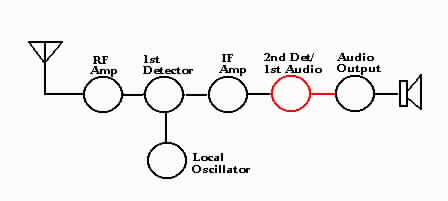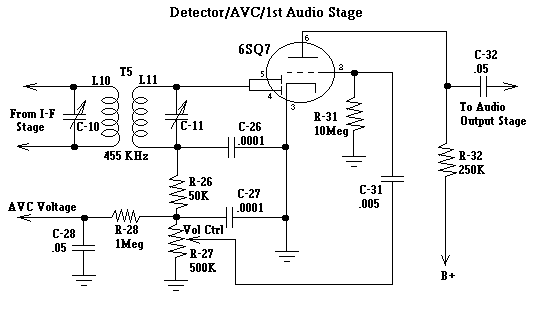Troubleshooting The Detector/AVC/1st Audio Stage
 |
 |
 |
The charts below give symptoms and possible caused for the detector/AVC/audio amp circuits. Refer to the schematic diagram above.
| Step | Check | Response | Possible cause |
|---|---|---|---|
| 1 | Apply an audio frequency signal to plate (pin 6) | Tone not heard or weak | Open coupling capacitor C-32 |
| Tone heard in output | Proceed to step 2 | ||
| 2 | Apply AF test signal to first AF grid (pin 2) | Tone not heard or weak | Defective tube,
substitute a know good one Missing plate voltage (R-32 open) If grid lead is shielded, check for shorted center lead to shield |
| Tone heard in output | Proceed to step 3 | ||
| 3 | Apply AF test signal across volume control R-27 | Tone not heard or weak | Open coupling capacitor C-31 Open volume control If lead to volume control arm is shielded, check for shorted center lead to shield |
| Symptom | Abnormal reading | Check for |
|---|---|---|
| Poor tone quality | First AF plate (pin 6) voltage low | Shorted or leaking coupling capacitor C-32 Plate resistor R-32 increased in value |
| Voltages normal | Shorted or leaking coupling capacitor
C-31
Incorrect value of grid resistor R-31 | |
| Hum | Voltages normal | Defective tube,
replace with known good one Incorrect routing of grid leads Incorrect position of coupling capacitor |
| Motorboating | Open grid resistor R-31 | |
| Intermittent reception (fading) | Coupling
capacitors C-31 and C-32 may be open intermittently Defective tube Defective volume control R-27 | |
| Step | Check | Response | Possible cause |
|---|---|---|---|
| 1 | Apply a modulated signal at the intermediate frequency to grid of preceding I-F stage. If modulation note is not heard, tune the generator either side of the intermediate frequency. | The modulation is heard at an off-frequency setting | The I-F stage is out of alignment. Perform I-F alignment procedures outlined for the receiver |
| The modulation note is not heard | Proceed to step 2 | ||
| 2 | Apply the I-F test signal to the plate of the I-F tube at the intermediate frequency. Set the attenuator for full output | The modulation note is heard in the speaker | The trouble is in the I-F stage. Refer to troubleshooting the I-F stage |
| The modulation note is not heard | Defective tube Open I-F transformer winding Shorted I-F trimmer capacitor |
| Symptom | Check for |
|---|---|
| Hum | Defective tube Incorrectly dressed leads in the diode plate return circuits If set has phono input, check for open wiring or shielding of input circuit |
| Weak reception and oscillation | Incorrect alignment Open AVC by-pass capacitors C-28, C-29, and C-30 |
| Distortion on strong signals | Leaky AVC by-pass capacitors
C-28, C-29, and C-30 Open resistor R-28 |
| Tube element | Pin No. | Volts |
|---|---|---|
| Plate | 6 | 100-170 |
| Grid | 2 | 0 |
| Cathode | 3 | 0 |
   |